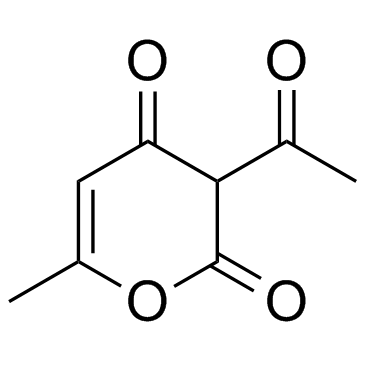Dehydroacetic acid

Dehydroacetic acid structure
|
Common Name | Dehydroacetic acid | ||
|---|---|---|---|---|
| CAS Number | 520-45-6 | Molecular Weight | 168.147 | |
| Density | 1.3±0.1 g/cm3 | Boiling Point | 332.6±42.0 °C at 760 mmHg | |
| Molecular Formula | C8H8O4 | Melting Point | 111-113 °C(lit.) | |
| MSDS | Chinese USA | Flash Point | 150.5±27.9 °C | |
| Symbol |

GHS07 |
Signal Word | Warning | |
|
Effects of preservatives on Alicyclobacillus acidoterrestris growth and guaiacol production.
Int. J. Food Microbiol. 214 , 145-50, (2015) Alicyclobacillus acidoterrestris can survive the pasteurization process, multiply in pasteurized juices and produce guaiacol which causes medicinal or antiseptic off-flavors. Chemical preservatives have the potential to suppress outgrowth of surviving populat... |
|
|
[Analysis of preservatives used in cosmetic products: salicylic acid, sodium benzoate, sodium dehydroacetate, potassium sorbate, phenoxyethanol, and parabens].
Kokuritsu Iyakuhin Shokuhin Eisei Kenkyusho. Hokoku. (128) , 85-90, (2010) Preservatives are used to inhibit the growth of microorganisms in cosmetic products. The Japanese standards for cosmetics set restrictions on the maximum amount of each preservative added to cosmetics as per the purpose of use of cosmetics. For the investigat... |
|
|
Simultaneous determination of eleven preservatives in cosmetics by micellar electrokinetic chromatography.
J. AOAC Int. 95(4) , 1069-73, (2012) A new method for the simultaneous quantitation of 11 preservatives-imidazolidinyl urea, benzyl alcohol, dehydroacetic acid, sorbic acid, phenoxyethanol, benzoic acid, salicylic acid, and four parabens (methyl, ethyl, propyl, and butyl)-in cosmetics by micella... |
|
|
Estimation of preservative concentrations in foods and their daily intake based on official inspection results in Japan in fiscal year 1998.
Shokuhin Eiseigaku Zasshi 42(6) , 404-12, (2001) The mean concentration and daily intake of five preservatives were estimated based on the results of an analysis of 89,927 samples of food obtained in official inspections by Japanese local governments in fiscal year 1998. The mean concentration of benzoic ac... |
|
|
Kinetics of the substitution of dehydroacetic acid in tris (dehydroacetato) Fe(III) complex by 8-hydroxyquinoline, di- and tetra-hydroxyquinone.
Spectrochim. Acta. A. Mol. Biomol. Spectrosc. 67(2) , 564-7, (2007) The ligand substitution reactions of dehydroacetic acid (Hdha) in [Fe(dha)(3)] with second ligand such as 8-hydroxyquinoline (Hquin), 1,4-dihydroxyanthraquinone (H(2)dhaq) and 1,4,5,8-tetra-hydroxyanthraquinone (H(4)thaq) were investigated spectrophotometrica... |
|
|
Antibacterial interactions of monolaurin with commonly used antimicrobials and food components.
J. Food Sci. 74(7) , M418-21, (2009) Monolaurin is a nontraditional antimicrobial agent that possesses better antimicrobial activities but causes no health problems to consumers, but the use of monolaurin in the food industry as a preservative is still limited. Using a microtiter plate assay, th... |
|
|
Anticoagulant effect of sodium dehydroacetate (DHA-S) in rats.
J. Appl. Toxicol. 28(4) , 524-9, (2008) Sodium dehydroacetate (DHA-S) is used as a food additive, preservative and antimicrobial agent. Repeated oral administration of DHA-S in rats induced severe hemorrhage in multiple organs and prolongation of blood coagulation factors. To determine the mechanis... |
|
|
Effect of extracted housefly pupae peptide mixture on chilled pork preservation.
J. Food Sci. 75(6) , M383-8, (2010) The peptide mixture from housefly pupae has broad spectrum antimicrobial activity but has not previously been reported as a food preservative. In this study, the preservation effects of a housefly pupae peptide mixture, nisin, and sodium dehydroacetate (DHA-S... |
|
|
Efficacy and tolerability of a combination of Lyprinol and high concentrations of EPA and DHA in inflammatory rheumatoid disorders.
Adv. Ther. 21(3) , 197-201, (2004) This 12-week drug-monitoring study was conducted to evaluate the efficacy of Sanhelios Mussel Lyprinol Lipid Complex on 50 adult men and women with inflammatory rheumatoid arthritis. A total of 34 patients required drug therapy before and during the study. By... |
|
|
Determination and depletion of dehydroacetic acid residue in chicken tissues.
Food Addit. Contam. Part A. Chem. Anal. Control. Expo. Risk Assess. 29(6) , 918-24, (2012) A high-performance liquid chromatography (HPLC) method was developed to determine dehydroacetic acid (DHA) residues in chicken muscle, liver and kidney. DHA was extracted using acetonitrile, and clean-up performed using a strong anion exchange (PAX) SPE colum... |